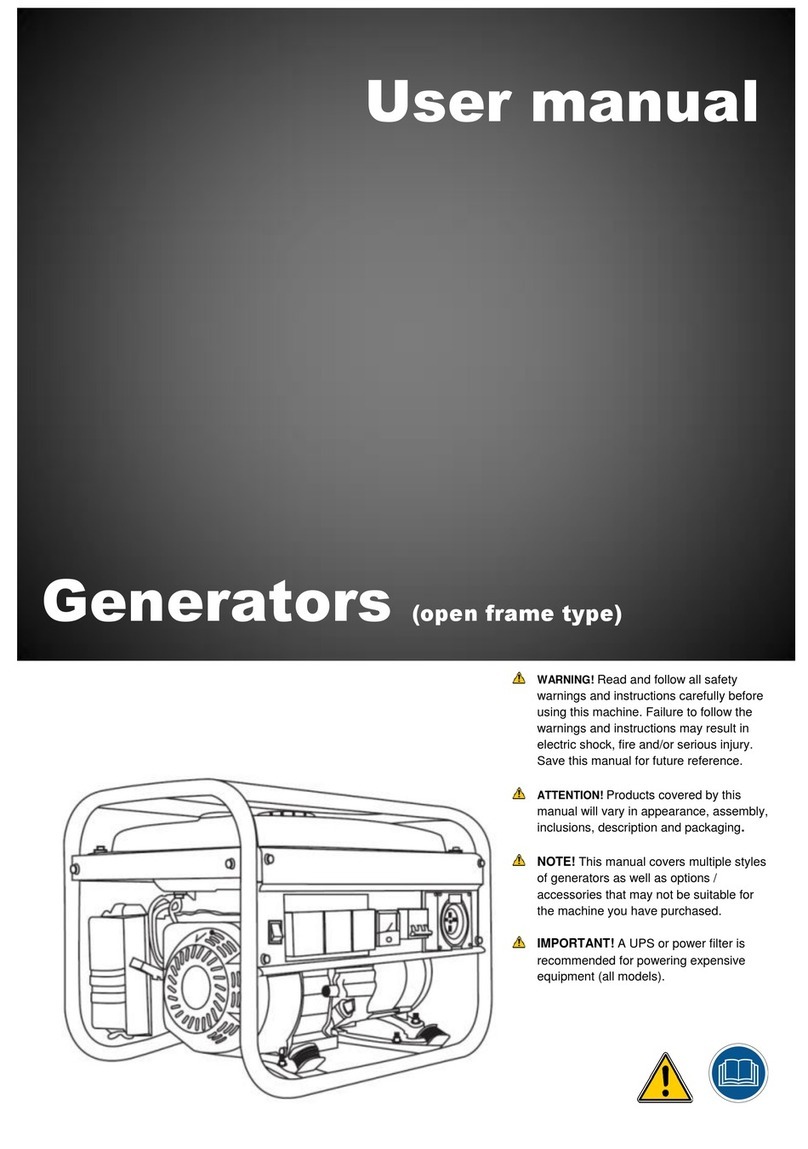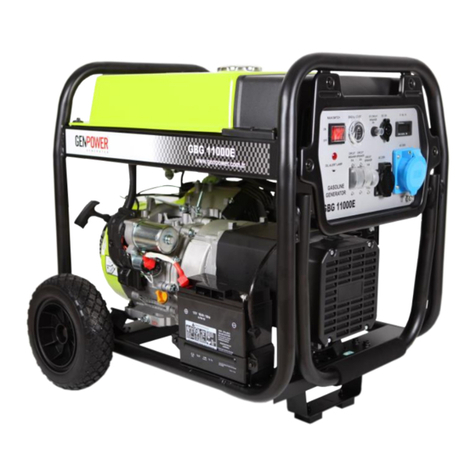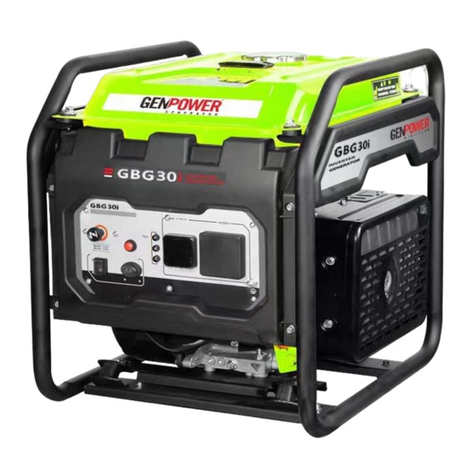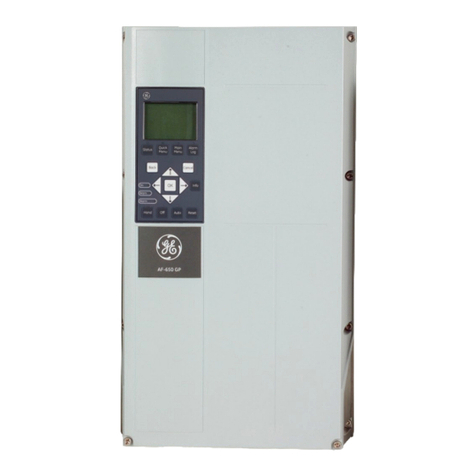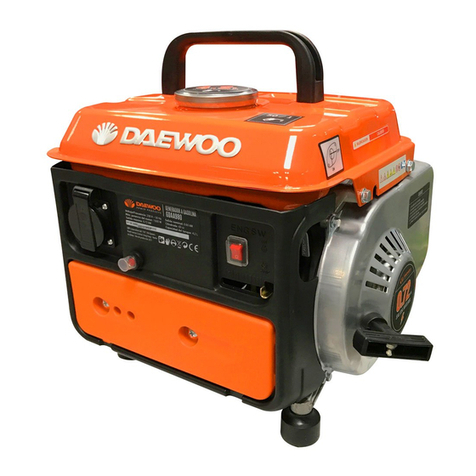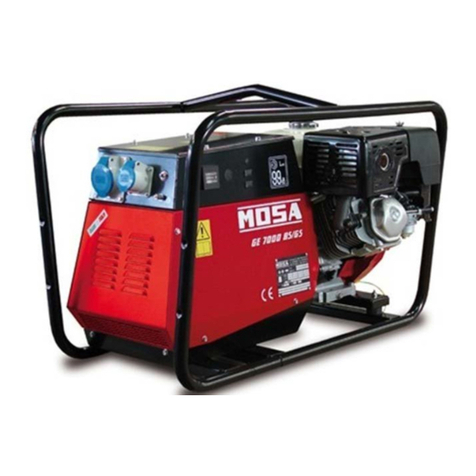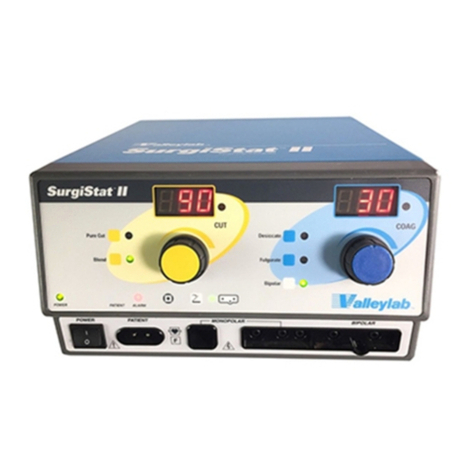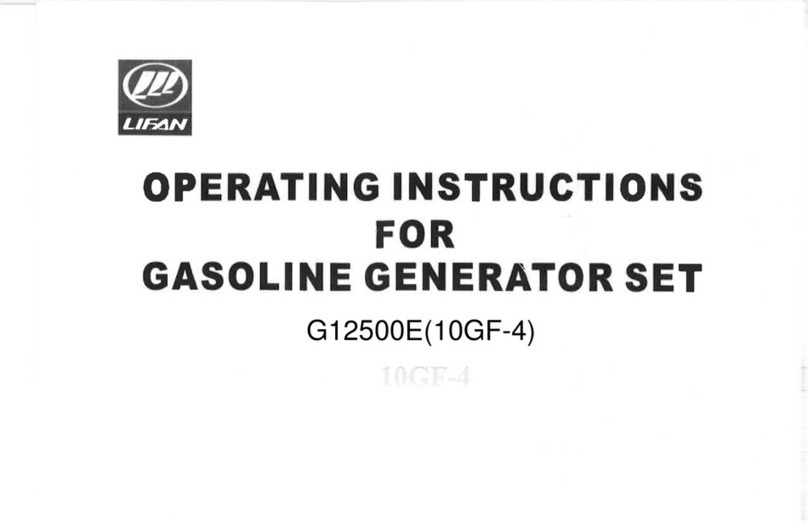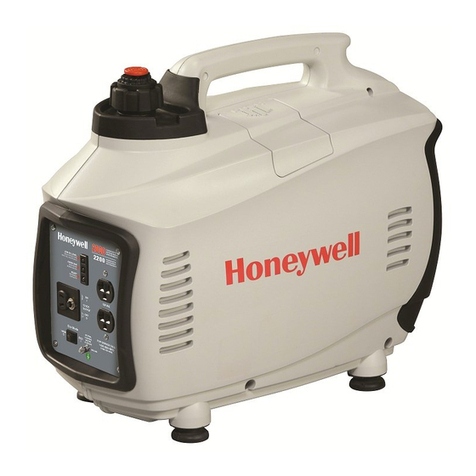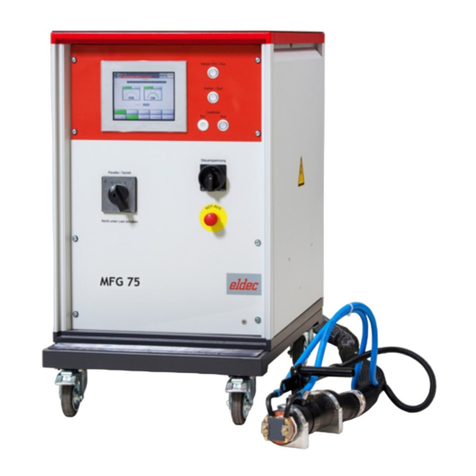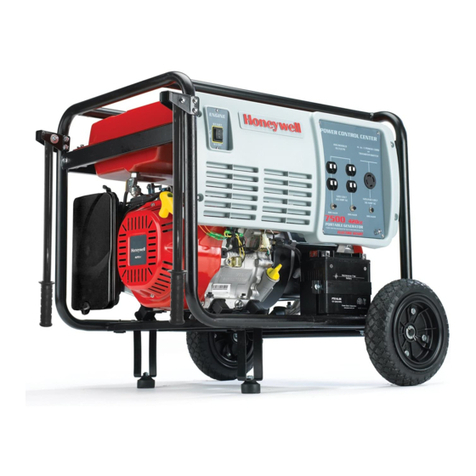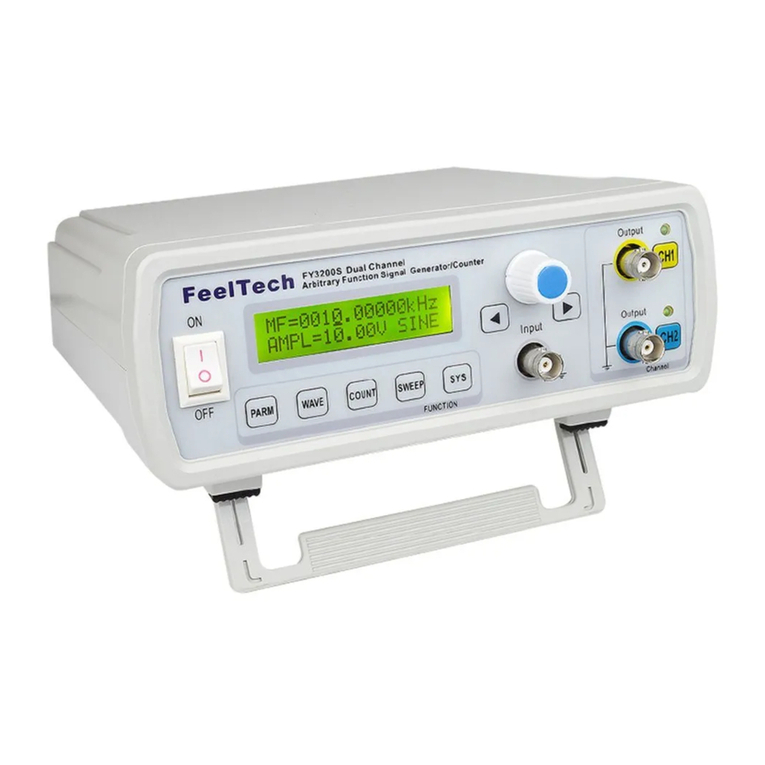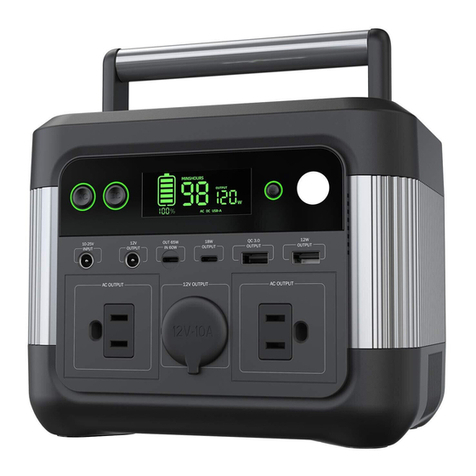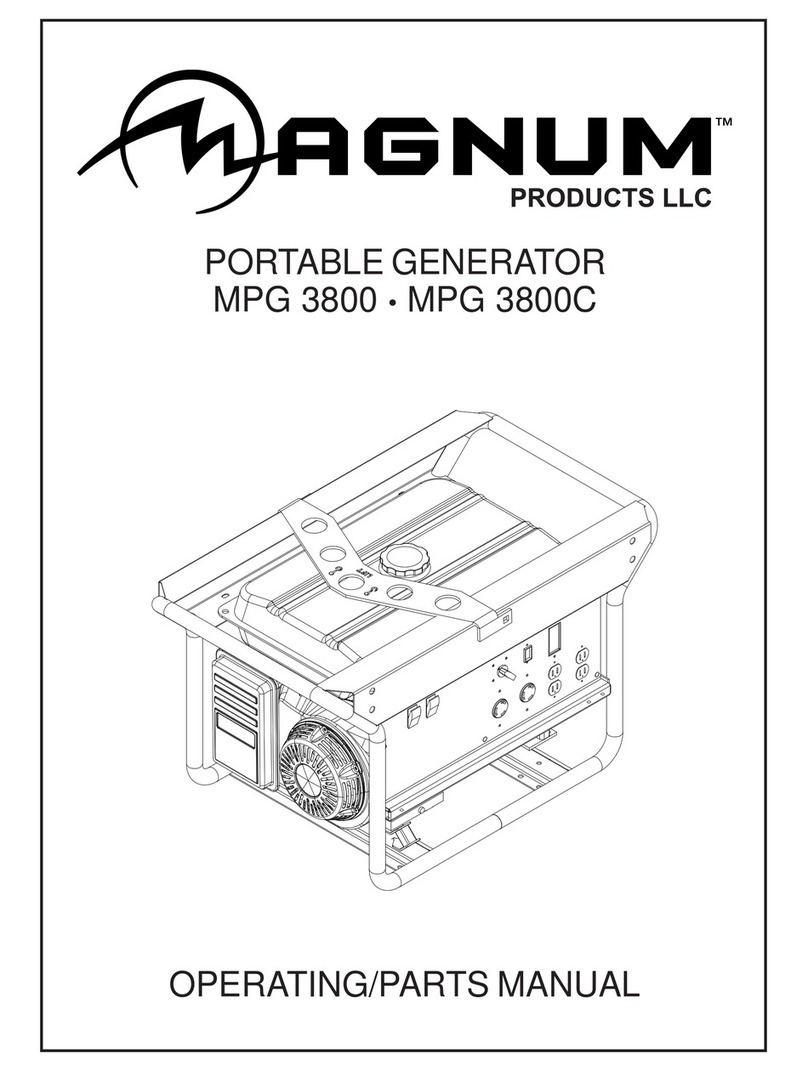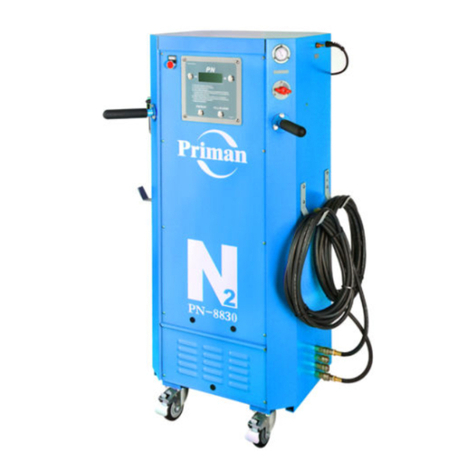GENPOWER GDG Series User manual

DIESEL PORTABLE GENERATORS
USER AND MAINTENANCE MANUEL
GDG SERIES

DIESEL PORTABLE GENERATOR USER AND MAINTENANCE MANUEL
2
DEAR GENPOWER GENERATOR SET USER;
Welcome to Genpower Family!
Thank you for choosing Genpower generator and hope your works will not be unfinished.
Genpower generator sets are produced in compliance with ISO 9001:2000 Quality Management System and
“CE”norms and in an environment-friendly way compatible to ISO 14001:2004 Environment Management
System.
Our generators are delivered to our end users by being subjected to a careful quality control and tests which are
applied in every stage of production. We are attempting to continuously improve our product and provide a
better service for you, with our staff specialized in their field of interests and in modern factory facilities.
Please read the operating manual carefully before initial starting of generator set and also recommend you have
it be installed by our authorized service in order to avoid from any unfinished matter.
This operating manual, for engine service–maintenance and alternator service–maintenance books are delivered
together with generator set.
This operating and maintenance manual was prepared in order to ensure users to easily handle the generator
and help them how they are going to make its maintenance. This is not a workshop repair manual.
The diesel portable generators is under guarantee for 1 (one) years or 1000 operating hours provided the use
of it in accordance with the matters stated in operating and maintenance manuals. Any repair or replacement of
parts caused by any modification held on the generator without giving consent of the original manufacturer or
by use of non-original parts are excluded from scope of guarantee.
We recommend you to make a periodical maintenance agreement with our authorized services which provide
continuous service for 7 days/ 24 hours in order to have much more performance and prolonged life -cycle of
generator.
Please comply with attention and warning indicators on the generator set and take necessary safety measures
mentioned in this manual for your safety and your surrounding lives.
Information included in this manual may not contain all features belonging to the generator.
Genpower has the right of making any amendment to improve the product quality without notifying.
GENPOWER GENERATOR
“Keep this manual for later assistance”

DIESEL PORTABLE GENERATOR USER AND MAINTENANCE MANUEL
3
GENPOWER GENERATORS
UNIQUE SUPERIOR FEATURES AND ADVANTAGES
Half A Century Old Experience in Generator Production
Low-level Noise
Advanced Technology and High-Quality Diesel Engines
Low-level Exhaust Emission
Advanced Technology and High-Quality Alternators
Low Operating Costs
Flexible Control Card Suitable for All Kinds of Applications
Low Fuel Consumption
Reliable and High-Quality Technology
Low Oil Consumption
Compact, Silent, Patented Design Canopy
Tropical, 50 °C Radiator
Compatible to Heavy Duty Conditions
Water and Particule Separated Fuel Filter
First Class Product Support
Durability
Abundant and Reasonable Cost Spare Parts
Global Network in Service and Maintenance

DIESEL PORTABLE GENERATOR USER AND MAINTENANCE MANUEL
4
IMPORTANT GENERAL INFORMATION
Generator Rating Definitions:
Genpower generators are produced in compliance with; TS ISO 8528-1, 8528-4, ISO 8528-5, BS500, ISO
3046/1:1985, IEC 60034, NEMA MG-1.22, BS5514/1 standard.
Standby Power (ESP) is defined as the maximum power available during a variable electrical power
sequence, under the stated operating conditions, for which a generating set is capable of delivering in the event
of a reliable utility power outage. over 24 hours of operation shall not exceed 70% of the ESP rating. Under the
condition of generator`s periodic maintenance has done in compliance with manufacturers maintenance
procedures, total operating time at 70% ESP rating shall not exceed 200 hours/year. For applications supporting
an unreliable utility service, the Prime Power (PRP) rating should be used.
Prime Power (PRP) is defined as being the maximum power which a generator set is capable of delivering
continuously whilst supplying a variable electrical load when operated for an unlimited number of hours per
year. The permissible average power output over 24 hours of operation shall not exceed 70% of the PRP. Total
operating time at 100% PRP rating shall not exceed 500 hours/year. At 12-hour operating time %10
overloading can be done in one-hour zone, total operating time at overloading with 10% PRP rating shall not
exceed 25 hours/year.
Limited Continuous Power (LTP) Under the condition of generator`s periodic maintenance has done in
compliance with manufacturers maintenance procedures, total operating time at %100 LTP rating shall not
exceed 500 hours/year. No overload capability is available for this rating.
Continuous Power (COP) is defined as being able to supply utility power at a constant 100 percent load for an
unlimited number of hours per year. No overload capability is available for this rating.
Recommended to follow these instructions in selection and operation of generator;
• Generator, In Continuous Power, under the condition of generator`s periodic maintenance has done in
compliance with manufacturers maintenance procedures and is used original spare parts and oil in compliance
with manufacturer`s catalogues, may operate maximum %70 load at PRP.
• Generators shall not operated under the level of %50 at PRP rating. This may cause extreme oil consumption
in engine, after in a short while permanent and unrecoverable damages may occurs.
• Dual or triple sync, equally aged and with fault redundancy systems should be chosen if the power output
necessity is 1000 kVa and higher.
ATTENTION! NEVER LOAD GENERATOR TILL TEMPERATURE OF WATER REACH 60 ⁰𝑪 IN
MANUAL OPERATED GENERATORS.

DIESEL PORTABLE GENERATOR USER AND MAINTENANCE MANUEL
5
1. PART: SAFETY MEASURES
1.1. INTRODUCTION
Generator groups produced by our company have been designed and conceived by prioritizing all sorts of safety of lives and
property.
Generators should be installed and used in accordance with maintenance and operating rules stated in this catalogue both in
terms of using the generator economically for a long-term and ensuring continuous safety of life and property. Required safety measures
should be taken in advance during the installation, usage and maintenance. Safe operating responsibility of the generator set belongs to
people using and maintaining it. Provided that instructions, methods and safety rules in this manual are complied with, risk of accident
will decrease.
Otherwise, unexpected defects and accidents which may result within serious injured and death of people and damage on the
equipment. Please have your generator used and maintained by well-trained people who issued or authorized persons in order to prevent
these occasions.
Please plan any part, machine or engine you are operating in a way to ensure easy access to every point. Take pre-safety
measures about how you can avoid from exposure to occasions like touching with rotating parts, burning and cut with sharp edges while
checking out the engine. Ensure that covers of turbo compressor driving shaft, pump shaft, fan belts and winglets among engine
components are fitted.
Never operate your generator when it is broken down and in unsafe conditions. Always isolate accumulator negative (-) lead
terminal by separating from the accumulator. Bring attention of people by hanging a WARNING/CAUTION sign on the engine or its
neighboring.
Never make any maintenance or repair while the generator set is operating. Turn off the generator and take all safety measures
before any maintenance initiated.
Never have unauthorized persons repaired and maintained, this will cause damage in your generator and also be out of from
scope of guarantee. We recommend you to use our authorized services providing 7/24 service.
1.2. ATTENTION! DON’T DO THE FOLLOWINGS:
The proper fuel for the diesel generator set is light diesel fuel. Do not use gasoline, kerosene and or other fuels other than
light diesel fuel,
Do not carry the generator on its side or in an inclined position during transportation. Oil or fuel may overflows into the air
filter and wets the filter, and the filter will not work if it does not absorb enough air. If this happens, remove the filter, wash it until the
oil or fuel is clean, dry it and put it back or replace it with a new one.
Don’t start the engine indoors. Exhaust gases are odorless and can be deadly as they contain carbon monoxide.
Do not insert your hands and feet into moving or rotating parts.
Do not store, pour or use fuel near open flames or appliances such as stoves, water heaters or sparking devices.
Do not refuel in places such as poorly ventilated rooms. Do this in an open area.
Do not refuel while the engine is running. Allow the engine to cool for 20 minutes before filling the gas tank. Store fuel in safe
containers.
Do not remove the fuel tank cap while the engine is running.
Do not start the engine in the presence of fuel odor or other explosive conditions.
Do not start the engine if it is overflowing or dripping fuel. Move the generator away from the stream and block ignition until
the fuel has evaporated.
Do not carry the generator from one place to another with fuel in the tank.
Do not smoke while refueling.
Do not run the engine at excessive speed. This can lead to accidents.
Do not touch the speed lever, links or parts that can increase speed.
Do not change the engine speeds selected by the manufacturer.
Do not hit the flywheel with a hard object while it is operating, it may break. Use the correct tool for servicing.
Do not run the engine without a muffler. Check frequently and replace if necessary. If there is a muffler deflector, check it
periodically and replace it with the correct deflector if necessary.
Do not run the engine in the presence of flammable materials around the muffler.
Do not touch the hot muffler, cylinder or cooling fins as this will cause burns.
Do not operate the engine without the air cleaner, air cleaner cover and/or carburetor air intake cover.
1.3. ATTENTION! DO THE FOLLOWINGS:
Even if mains is not off, run the generator for at least 5-10 minutes every once in a while (once a week) so that the battery
does not discharge, your battery will remain constantly charged. Because dry batteries complete their life after they are discharged.
If your generator is a system with accumulator (E, EC, ECX or TECX series generators), remove the negative (minus)
terminal of the accumulator.
If your generator is accumulator started, do not neglect accumulator maintenance and cleaning. Keep the accumulator away
from sparks, especially during charging. Accumulator acid is corrosive. It is especially dangerous for the skin and eyes.

DIESEL PORTABLE GENERATOR USER AND MAINTENANCE MANUEL
6
When repairing the electrical circuit is required, first disconnect the cables connected to the battery terminals.
Clean the cylinder cooling fins and speed governor parts as they can affect engine speed.
Check the muffler periodically to make sure it is working properly. Worn leaking muffler should be repaired or replaced.
Use fresh diesel fuel. Stale fuel can cause gumming and leaking in the carburetor.
Check the fuel connections and gaskets for cracks and leaks. Renew if necessary.
When the battery-started generator is not running, always remove the ignition key to prevent accidental starting.
Always keep the fuel cock closed when you do not start the generator.
Accumulator compartments boxes are manufactured in a safe way. Do not allow any occasion which may cause bare flame or
electric arc near the accumulators. Hydrogen gas emitted from the accumulators may cause very serious injuries since it is so
combustive and inflammable. Never disconnect lead terminals, impact on and bend over them while the engine is starting or operating.
Have sufficient amount of fulfilled fire extinguisher present near to the generator.
1.4. MOVING COMPONENTS AND IRRITATING MATERIALS:
As a general maintenance rule; ensure diesel engine is on STOP state or its covers are installed on it. Never operate engines
without protection guard which are disassembled except the case that exceptional maintenance and settings must be performed.
Coming close to an operating engine is a safety risk. Remember wide and loose clothes, long hairs may cause serious
accidents by being put on rotating components.
Putting tools or equipment down on operating engine due to incaution may lead to serious injuries in case of close contact to
the engine.
Avoid from touching with operating engine exhaust system.
Install materials for safety and protection purpose disassembled during the service on their places before starting the engine.
Avoid contact diesel fuel, oils, cooling water and accumulator electrolyte used in the engine with your bare body.
Wear protection gloves and oil proof clothes while engaging with these works.
Oils, especially used oils influence under the skin and so may lead to irritation and eczema on skin.
Thoroughly wash your skin after contact with oil and use protective creams.
Always use face mask and acid proof clothes while working with the accumulator.
Hot oils may cause burns. Do not touch hot oil, your skin may burn. Ensure there is no pressure in the system before starting
to work while operating with the lubrication system.
1.5. EXHAUST GASES:
Breathing exhaust gases is toxic and dangerous. Operate the generator on OPEN air or in environments with a good air
circulation.
Take attention that exhaust gas outlet points do not exhaust to human living areas or near to air intake channels.
Do not operate the generator in the exhaust system having gas leakage.
1.6. ELECTRIC SHOCK AND FIRST AID:
1.6.1. What Is First Aid?
In the event of an accident or life-threatening situation, the treatment without medicines is called first aid until the assistance
of the medical staff is provided, in order to prevent life from getting worse or worse.
FIRST AID APPLICATION IS ABSOLUTELY NOT USED.
1.6.2. What Is The Purpose In First Aid?
Protection and maintenance of life
Prevent deterioration of the situation
Facilitate the healing process.
1.6.3. What Are The Features And Responsibilities Of The First Aider?
He must be calm and unhurried.
Keep the patient calm.
Determine whether there is a danger that evaluates the environment.
Do not endanger the safety of his / her life.
Organize the people in charge to inform health institutions, fire and security.
Evaluate the condition of the patient and begin appropriate first aid.
Ensure that the patient arrives at the health facility as soon as possible.
1.6.4. What are the basics of First Aid?
Opening of the breathing passage

DIESEL PORTABLE GENERATOR USER AND MAINTENANCE MANUEL
7
Correcting the respiratory system.
Ensuring activity of the circulatory system.
1.6.5. First Aid In Electric Shock
First ensure your own (first-aider) safety.
Turn off the source of electricity, if possible.
If not, move the source away from you and the person, using a dry, nonconducting object like plastic or wood.
Begin CPR if the person shows no signs of circulation, such as breathing, coughing or movement.
Apply a bandage. Cover any burned areas with a sterile gauze bandage.
1.6.6. First Aid for Carbon Monoxide Poisoning
The patient is immediately moved to fresh air.
Deep breathing is carried out in the fresh air.
CPR is applied to patients who are unable to breathe or breathe.
Cover the top of the body to prevent the patient from chilling.
The patient shall be sent to the health center immediately.
1.6.7. First Aid for Bleeding
If the wound is on the arm or leg, raise limb above the heart, if possible, to help slow bleeding.
Apply direct pressure on the cut or wound with a clean cloth, tissue, or piece of gauze until bleeding stops.
Apply a tourniquet if the bleeding is severe and not stopped with direct pressure in 5 minutes.
1.6.8. First Aid for Minor Burnings
Cool the burn. Hold the burned area under cool (not cold) running water or apply a cool, wet compress until the pain eases.
Remove rings or other tight items from the burned area.
Don't break blisters.
Bandage the burn. Cover the burn with a sterile gauze bandage (not fluffy cotton)
2. PART: BEFORE STARTING
GENPOWER generators have been produced in international standards.
Our air-cooled diesel portable generators have some of the following features:
●Lightweight construction
●Air cooled
●Four-stroke diesel internal combustion engine
●Direct fuel injection system
●Recoil starter or an optional electric starter
●Large fuel tank
●Automatic voltage stabilizer
●NFB circuit protector
●AC and DC outputs
●Low oil pressure alarm
There is an oil level sensor in the generators to prevent damage to the engine in case of oil shortage. When the oil level falls
below a certain level, this sensor does not allow the generator to operate.
Use 15W40 oil.
Each generator has a group identification plate. Serial number, qualifications, weights and manufacturing date of generators
are written on this group plate. Use this serial number in spare parts, repair claims, interviews and at your demands.
It is recommended to use high quality detergent oils classified as SE, SF, SD or SC. Detergent oils keep the engine clean and
prevent gumming and deposits. Nothing should be added to the recommended oil. The viscosity of the lubricating oil used should be
selected in accordance with the ambient temperature range in which the engine operates.
30

DIESEL PORTABLE GENERATOR USER AND MAINTENANCE MANUEL
8
2.1. FILLING OIL:
ATTENTION! Your generator has been shipped without oil. Before using, be sure to fill in the oil. Do not ship with oil.
Put the generator on a flat surface.
Clean up around the mouth of the oil tank.
Remove the oil filler plug or rod, fill the oil slowly. If there is an oil plug, fill up to the overflow point. If there is a oil
dipstick, fill it to the FULL point on the dipstick. Do not overfill.
.
ATTENTION! Do not rotate the dipstick.
Put the oil plug or dipstick in its place.
Figure 1
Figure 2
Figure 3
Dipstick
Bolt To Drain Lubricating Oil
Bolt To Drain Lubricating Oil
Dipstick

DIESEL PORTABLE GENERATOR USER AND MAINTENANCE MANUEL
9
2.2. CHECKING THE OIL LEVEL:
Put the generator on a flat surface.
Remove the dipstick and wipe it with a clean cloth.
Put the dipstick back in place.
Take it out again to check the oil level.
While engine running, the dipstick should be firmly seated in its socket.
2.3. DIESEL FUEL RECOMMENDATIONS:
Use only light diesel fuel,
The fuel should be filtered clean,
Never let dust and water mix with fuel in the fuel tank, otherwise it will clog the fuel lines and oil nozzles. It may also damage
your pressure pump,
It is dangerous to overfill the fuel tank.Never exceed the red piston in the filter.
Purchase the amount of fuel to be used in the 30-day period. This ensures fuel freshness and the required fuel viscosity
according to the season.
Do not open the fuel cap while the engine is running.
2.4. RECOMMENDATIONS FOR AN EFFICIENT PERFORMANCE:
Keep the generator flat while filling, storing and operating with oil and fuel.
Do not use pressurized starting fluid.
Use oil suitable for the temperature.
Do not start the engine with a low oil level.
Run the generator at no load (idle) once in a while.
Use fresh fuel.
A hot battery has more starting capacity than a cold battery.
If the engine is cold, make sure to adjust the choke fully.
A hot engine requires less choke than a cold engine.
Engine oil is the most important factor in determining the life of your generator engine. If you use poor engine oil or if you
don’t change the oil regularly,the piston and cylinder will wear easily or seize up. Also the life of the other parts in your engine such as
bearings and other rotating parts will shorten considerably.
Although there is an alarm system to check for low oil pressure,please check the amount of oil inside the engine regularly. If
the oil level is low,fill it before starting the engine.
It is more easy to drain the oil from the engine is when the diesel engine is still hot. If the engine is fully cooled,it is more
difficult to drain all the oil out or some impurities will remain in the engine.
Figure 4

DIESEL PORTABLE GENERATOR USER AND MAINTENANCE MANUEL
10
3. PART: MAIN PARTS OF THE GENERATOR:
ATTENTION! Below picture shows a typical portable diesel portable generator’s parts! Parts may vary from model to model.
4. PART: STARTING GENERATOR
ATTENTION! Before starting the generator
make sure the Circuit Breaker is in the “OFF” position
,
Starting the generator with
the switch in the “ON” position is very dangerous.
ATTENTION! Before starting the generator
make sure the generator should be grounded in order to prevent electric shock..
Figure 5
Figure 6
Circuit Breaker
Fuse
DC Output
AC Output Socket
Warning Lamp

DIESEL PORTABLE GENERATOR USER AND MAINTENANCE MANUEL
11
4.1. Insert Key: Insert key into start switch and turn it in the “OFF” position.
4.2. Speed Lever: Move the speed lever in the “RUN”position as shown on the Figure 7.
4.3. Start Switch: Turn the start switch clockwise to the ‘‘START” position; set the silent type, first turn it
clockwise to the “RUN” (ON) position for 1-2 seconds. The electromagnetic iron will be triggered, now turn it
clockwise to the “START” position as shown on Figure 8.
4.4. After Starting: After the diesel engine is started, remove your hand from the switch handle; the switch will
automatically reset itself to the “ON” position.
4.5. If Not Started: If the engine is not started after 10 seconds of cranking, wait about 15 seconds before trying it
again. If you crank to long, the voltage of the battery will drop. This can lead to improper ignition. When the
diesel engine is operating, let the ignition retain on the “ON” position.
Figure 7
Figure 8
Speed Lever
STOP
RUN

DIESEL PORTABLE GENERATOR USER AND MAINTENANCE MANUEL
12
4.6. Loading:
4.6.1. Load Conditions: Exert loads in accordance with the specified parameters.
4.6.2. Output of Electricity:
4.6.2.1. Raise the revolutions per minute (turn the speed lever to the max setting) of the generator to get the maximum
power out of the generator. If not,the automatic voltage regulator device will excite and doing this for long pe-
riods of time will cause the capacitor to burn.
4.6.2.2. Observe the pointer of the voltmeter, it should point to 230V/400V±5%(50Hz).(For 60Hz set, it will be
240V±5%). Meanwhile put the switch in the GEN position. The AC voltage from the socket of the power
supply can be output.
4.6.2.3. When connecting devices to the generator,make sure to connect these devices in order. Connect the bigger
loads onto the generator first.
4.6.2.4. If everything is functional,smaller loads can then be added.If the generator shuts off, it may be because the
load being drawn by all the various devices are too high.In this event,decrease the number of small devices
until everything is functional.
4.6.2.5. The total load should not exceed the maximum output power of the generator.In order to reset the generator
after overload,let it be steady for several minutes.If the indication of the voltmeter is too high or too low,
adjust the speed accordingly.If there are problems, stop the generator immediately and fix the issue.
4.7. Charging The Battery:
For the electric starter on the generator,the 12V battery is automatically charged through the regulator on the side of the
engine when it is running.
If the generator is not used for long periods of time,the battery should be disconnected to avoid energy loss from the battery.
Do not connect the negative and positive terminals of the battery together at any time.Doing so will damage the battery.
Do not reverse the polarities when attaching the battery cables to the battery.Doing so will damage both the battery and the
electric starter.
When charging the battery, the battery produces flammable gases.Do not smoke,let flames,and sparks far away the battery
while it is charging as this may cause a fire.To avoid sparking while connecting the cables,connect the cables to the battery
then to the engine. To disconnect battery cables,first disconnect the engine end of the cable.
ATTENTION! Do not start more than two devices simultaneously
.
Each device should be started one by one to prevent
overloading the generator. The generator should be running at 3000/3600 RPM in order to achieve the (50/60Hz) frequency
.
The
speed of the engine can be adjusted from the speed governor.
5. PART: STOPPING GENERATOR
Before stopping the generator, always disconnect it from the load.
Put the speed lever in the ‘‘RUN” position and let the engine run for 3 minutes after unloading. Do not stop the diesel engine
immediately, let it warm down.Stopping the diesel engine suddenly may raise the temperature of the engine abnormally may lock the
nozzle and damage the diesel engine.
Turn the key switch to the "OFF" position,
6. PART: MAINTENANCE
General maintenance of the generator is described in this section.
Always have authorized persons or authorized services maintained your generator set. Note that guarantee will be void in case
of maintenance, repair and setting made by unauthorized services or persons.
Always use original spare parts in maintenance and repair. Never use non-original parts or those approved by Genpower in
written form.
Guarantee of the generator set will be void as a result of damages caused by non-original maintenance or repair parts.

DIESEL PORTABLE GENERATOR USER AND MAINTENANCE MANUEL
13
Comply with safety measures mentioned in previous sections while performing the maintenance.
ATTENTION! When servicing your generator, disconnect the spark plug wire from the spark plug to prevent the engine from
starting suddenly. Disconnect the accumulator, if any. Take safety precautions and follow them.
6.1. Check Oil Level Regularly: Check every 5 hours of operation or daily. Make sure the oil level is just right.
6.2. Oil Change:
*Replace oil after the first 5 hours of use.
* Under normal operating conditions, engine oil should be changed every 50 working hour.
* At high temperatures and loads the oil should be changed every 25 hours.
* When the engine is warm drain the oil by removing the oil drain plug and replace the plug. Fill the oil with the recommended
oil.
6.3. Air Filter Maintenance:
After every 500 hours of operation or 6 months, perform cleaning maintenance.
If necessary, replace it,
Do not use detergent to clean air filter element,
When the performance of the engine decreases or when the color of the exhaust gases is bad, replace the filter element.
To check the air filter; loosen the butterfly nut, take the cover of the air filter off and take the air filter element out as shown
on Figure 10.
After replacing the air filter element,replace the cover and tighten the butterfly nut firmly.
ATTENTION! Perform maintenance more frequently in dusty conditions.
ATTENTION! Never start the engine without the air filter
.
This can cause serious damage to the engine if foreign objects enter the
intake system
.
Always change the air filter on time.
Figure 9
Figure 10
High Pressure Fuel
Pipe Bolt
Oil Drain Bolt
Dipstick
Filter
Butterfly Nut
Air Filter Cover

DIESEL PORTABLE GENERATOR USER AND MAINTENANCE MANUEL
14
6.4. Fuel Filter Maintenance:
The fuel filter should be cleaned often to keep the engine running at maximum performance,
The recommended time period for cleaning the fuel filter is 6 months or 500 hours of operation,
To do this, first drain the fule from the fuel tank,
Loosen the small screws on the fuel switch and remove the fuel filter form the port.Use diesel fuel to clean the fuel filter.
Also remove the fuel injector and clean the carbon deposit around it. The recommended time period for this is 3 months or l00 hours.
6.5. Cleaning of Generator:
Remove dirt and debris with a cloth or brush and clean it.
Water jet washing does not recommended due to engine fuel system with alternator winding and electrical equipment may
break down.
Do not keep combustible parts on or near of exhaust muffler.
Generator cooling provided by the air flow passing over it. Therefore, the air ducts on the engine body and the alternator air
outlet windows must be open and clean.
Grass and dirt can clog the starter guard and the air cooling system becomes inadequate, especially as a result of extended
maintenance time.
Every 100 hours or every season, remove the starter guard and clean the area shown in Figure 11.
6.6. Storing for long periods of time: If your generator needs to be stored for long periods of time, the following
preparations should be made.
6.6.1. Start the diesel engine for 3 minutes then stop it,
6.6.2. When the engine is still hot,change the engine oil with new engine oil of the proper grade.
6.6.3. Pull the rubber plug out of the cylinder head cover and put 2CC of lubricating oil in it,then cover the plughole up
again.
6.6.4. Press the decompression handle down and crank the engine for 2-3 seconds.To do this,put the starter switch in the
“Start” position.(Do not start the diesel engine)
6.6.5. Clean the genset and store it in a dry place.
Figure 11

DIESEL PORTABLE GENERATOR USER AND MAINTENANCE MANUEL
15
6.7. Example Of Maintenance Schedule:
PERIOD
ITEM
Daily
First
Month
Every 3
Months
Every 6
Months
Every 1
Year
Engine Oil Check
Check
Replace Engine Oil
Replace
Replace
Air Filter Check
Check
Air Filter Wash
Clean
Oil Filter
Clean
Battery Electrolyte Level
Clean
Valve Clearance
Check,
Readjust
Cylinder Cover Wash
Clean
Fuel Tank
Replace every 3-year
7. PART: TROUBLESHOOTING
Causes of Malfunction
Responsive Action
Not enough fuel
Add enough fuel
The switch of fuel is not at “OPEN” position
High-pressure pump and nozzle do not inject
Turn the switch of fuel to“OPEN” position
Fuel or the injected amount is less
Disassemble the nozzle and adjust it at test
table
Speed control lever is not at “RUN”position
Tum speed control lever to“RUN” position
Check level of lubrication oil
The standard oil amount of lubricating oil should
be between high graduation“H”and low
graduation“L”
It is not quick and powerful to pull reactive starter
Start diesel engine in accordance with the
requirements of“start operation
procedures”
Nozzle exists dirt
Clean the nozzle
The Battery is lower power
Charge the battery or replace it
Causes of Malfunction
Responsive Action
Master switch is not be switched on
Turn capacity switch handle to “ON” position
Carbon brush of generator was worn,
Replace the carbon brush
The contact of socket is not working properly
Adjust the contact of socket
The electric switching is not working properly
Make it reach to the rated revolution in
accordance with the requirements
AVR automatic governor is damaged
Replace it
The fuse is not working
Replace it
GENSET Not Started
GENSET Not Generates

DIESEL PORTABLE GENERATOR USER AND MAINTENANCE MANUEL
16
THANK YOU FOR CHOOSING GENPOWER GENERATOR SETS, WE WISH FOR YOU TO USE
YOUR GENPOWER GENERATOR THROUGH LONG AGES IN ACCORDANCE WITH THESE
OPERATING AND MAINTANCE MANUAL.
GENERAL DIRECTORATE
ASO II. Industrial Zone
2010. Street No: 18
06909 Temelli-Sincan/Ankara, TURKEY
Phone/ Fax: +90(312) 641 32 22 - 641 32 23
genpower@genpower.com.tr
www.genpower.com.tr
Table of contents
Other GENPOWER Portable Generator manuals
